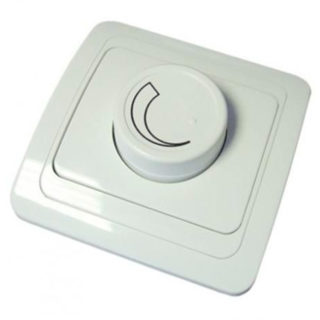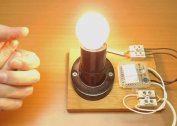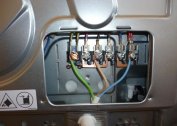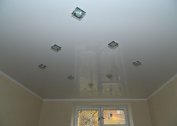In a lighting device, a part such as a dimmer is often used. The device can be used in electrics when creating a lighting scheme at industrial facilities, in retail, office and residential premises. The main task is to change the parameters of light.
About device
To understand what a dimer is in an electrician, you need to look at the origin of the word: dim in English means "dimming." The element controls the electrical power in the network, making the brightness higher or lower. Another common product name is dimmer.
There are models designed for LED, halogen light sources, as well as incandescent lamps. Modern dimmers differ in design, installation method, type of adjustment and other parameters.
Development history
In the 19th century, Johann Poggendorf, a German scientist, invented a variable type resistor, or rheostat: the device was designed to change the current and voltage in an electrical circuit by adjusting the resistance. Such a resistor can be considered the first kind of dimmer for changing light: in order to lower the brightness, it is necessary to reduce the voltage. The disadvantage of the design is increased heating and a low level of efficiency.
Already in the XX century autotransformers were developed: they are distinguished by an increased efficiency, stable voltage in the entire range. However, these devices have considerable dimensions and weight, are expensive. The most practical solution is electronic dimmers: they are compact, easy to operate, reliable. It is this variety that has received the greatest distribution. A popular embodiment is a switch equipped with a dimmer. Such a device is universal and has a wide range of applications.
Scope of use
The use of dimmers is very widespread:
- living quarters where it is required to lower the brightness of light bulbs at certain hours (for example, a bedroom, a children's room);
- technical and commercial halls, in which they do not turn off the lights at night, but reduce the degree of illumination, putting the system in an energy-saving mode;
- rooms where a change in the light flux allows you to focus on an object, zoning the room, visually expanding, or, conversely, reducing the free space.
Modern automatic dimmers are often used in organizing public and personal holidays. They are indispensable in arranging lighting for clubs, concert venues, and exhibitions.
Operating principle
 The main element of the dimmer is the key, it is also a switch, the operation of which is regulated by a thyristor or triac device. To reduce the brightness, a current supply from the cut-off sinusoidal shape is required, for this a thyristor is used, which cuts off the leading or trailing edges. The choice of control method depends on the type of lamp:
The main element of the dimmer is the key, it is also a switch, the operation of which is regulated by a thyristor or triac device. To reduce the brightness, a current supply from the cut-off sinusoidal shape is required, for this a thyristor is used, which cuts off the leading or trailing edges. The choice of control method depends on the type of lamp:
- for compact fluorescent bulbs and undervoltage devices, electromagnetic transformers with a leading edge are used;
- for halogen and LED lamps, electronic regulators with a voltage change on the trailing edge are used.
In addition, the dimmer circuit includes components that protect the fixture from overheating and damage during short circuits. To reduce electromagnetic distortion, the system is supplemented with capacitive inductive filters or a special inductor is connected.
Pros and cons of fixtures
A dimmer switch has many advantages:
- automatic operation, self-shutdown;
- the ability to adjust the light parameters through the radio channel, through the noise effect (for example, clap), voice, using infrared radiation;
- compatibility with various lamps: white light devices and color LEDs;
- protection of bulbs from burnout during power surges;
- the ability to simulate the presence of the owners of a house or apartment, which helps protect the property from unauthorized entry;
- effective use in creating color music.
At the same time, dimmers also have disadvantages. These include the following nuances:
- risk of electromagnetic interference;
- nonlinear dependence of the output voltage characteristic;
- some lamps, for example, those connected via ballasts, do not work with dimmers;
- non-sinusoidal output voltage;
- low efficiency in contact with incandescent bulbs.
Most of the disadvantages can be eliminated if you choose the right lamp and do not use step-down transformers.
Classification
There are many options for the implementation of dimmers, which may differ in the following technical parameters:
- Type of adjustment. By this criterion, dimmers are divided into mechanical, sensory, acoustic and remote. The first variety works when you turn the knob or press a button, the second is equipped with a touch panel. Acoustic controls are controlled by voice, they are often made an element of the Smart House system. Remote models work from the remote control.
- Execution of the body. It can be modular, block and monoblock. In the first case, the dimmer is mounted in a distribution switchboard, in the second the switch is combined with a dimmer, and in the third it is installed for phase discontinuity.
- Management method. Key controls are equipped with a button, holding it in one position allows you to set the desired type of lighting. Swivel-push models are equipped with a handle. When you want to reduce or increase the brightness, the handle is slightly sunk in the slot and make a turn. There are also simple rotary dimmers, they are controlled by rotating the handle.
- Type of connected lamps. On sale you can find dimmers for halogen, LED and incandescent lamps.
Not only the scope of operation depends on the type of device. Design features directly affect the price.
Rules for choosing a dimer for home
Before ordering such a device, the following parameters must be considered:
- type of bulbs with which the models in question are compatible;
- power consumption: it is better to take a product with a margin of 25-40% to protect the equipment from burnout;
- case and installation option: can be open and hidden;
- control method: the most convenient are remote and acoustic dimmers, however they are more expensive than mechanical devices;
- cost of equipment.
Choosing a dimmer dimmer, you need to pay attention to the country of production. The highest quality devices are produced in Europe and the USA. Chinese counterparts are cheaper, but their reliability is not so high.




